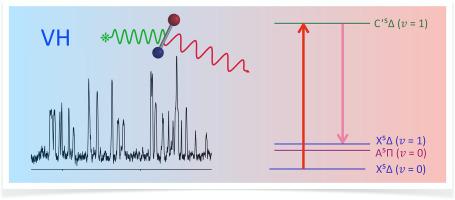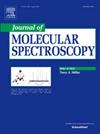A new electronic transition of vanadium hydride: The C′5Δ–X5Δ (1,0) band
IF 1.3
4区 物理与天体物理
Q4 PHYSICS, ATOMIC, MOLECULAR & CHEMICAL
引用次数: 0
Abstract
We report the observation and analysis of a new electronic transition in gas-phase vanadium hydride (VH), identified as the C′5Δ–X5Δ (1,0) band with an origin at 14,015 cm−1 (714 nm). The spectrum was recorded by laser excitation spectroscopy, with laser-induced fluorescence detected to the X5Δ (v = 1) level. Dispersed fluorescence measurements enabled a detailed characterization of the vibrationally excited ground state, yielding a vibrational interval of ΔG1/2 = 1606.6(2) cm−1. Despite the presence of significant local perturbations—particularly in the Ω = 0 and 1 spin components of the C′5Δ state—a full rotational analysis of the spectrum using a Hund's case (a) Hamiltonian was achieved. Spectroscopic constants including rotational, spin–orbit, spin–rotation, and Λ-doubling parameters are reported for both the new C′5Δ state and the X5Δ (v = 1) level. Additionally, we observed a small local perturbation in the X5Δ₁ (v = 1) level near J = 9, attributed to homogeneous spin–orbit and heterogeneous L-uncoupling interactions with the previously analyzed A5Π (v = 0) state. An X5Δ ∼ A5Π coupled Hamiltonian was used to model this perturbation and yielded interaction parameters roughly consistent with semi-empirical estimates. This work represents only the second analyzed spectroscopic transition of gas-phase VH.

氢化钒的一个新的电子跃迁:C ' 5Δ-X5Δ(1,0)带
我们报道了对气相氢化钒(VH)中一个新的电子跃迁的观察和分析,该跃迁被确定为C ' 5Δ-X5Δ(1,0)带,其起源为14,015 cm−1 (714 nm)。用激光激发光谱法记录光谱,激光诱导荧光检测到X5Δ (v = 1)级。分散荧光测量使振动激发基态的详细表征,产生的振动间隔ΔG1/2 = 1606.6(2) cm−1。尽管存在显著的局部扰动,特别是在C ' 5Δ态的Ω = 0和1自旋分量中,使用洪德情况(a)哈密顿量对光谱进行了全面的旋转分析。本文报道了新的C ' 5Δ态和X5Δ (v = 1)能级的光谱常数,包括旋转、自旋轨道、自旋旋转和Λ-doubling参数。此外,我们在J = 9附近的X5Δ 1 (v = 1)能级观察到一个小的局部扰动,这归因于与先前分析的A5Π (v = 0)态的均匀自旋轨道和非均匀l -解耦相互作用。使用X5Δ ~ A5Π耦合哈密顿量来模拟这种扰动,并得到与半经验估计大致一致的相互作用参数。这项工作只代表了第二次分析气相VH的光谱转变。
本文章由计算机程序翻译,如有差异,请以英文原文为准。
求助全文
约1分钟内获得全文
求助全文
来源期刊
CiteScore
2.70
自引率
21.40%
发文量
94
审稿时长
29 days
期刊介绍:
The Journal of Molecular Spectroscopy presents experimental and theoretical articles on all subjects relevant to molecular spectroscopy and its modern applications. An international medium for the publication of some of the most significant research in the field, the Journal of Molecular Spectroscopy is an invaluable resource for astrophysicists, chemists, physicists, engineers, and others involved in molecular spectroscopy research and practice.

 求助内容:
求助内容: 应助结果提醒方式:
应助结果提醒方式:


